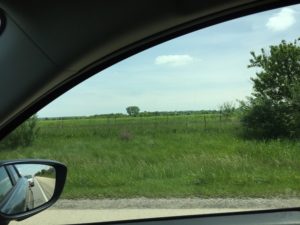Chalking up Illinois Nature Preserve #17 of 50 this year was a piece of cake. Sort of. I spent the early part of the morning monitoring grassland birds — as I do every spring — at Tract 104 within Midewin National Tallgrass Prairie. Then I jumped in the car and headed to the southwest side of Midewin to visit Grant Creek Nature Preserve.
 According to Google Maps, the preserve was accessible via a frontage road to I-55. However, turning onto the road, I immediately came to a closed gate, beyond which lay an unpaved, overgrown two-track.
According to Google Maps, the preserve was accessible via a frontage road to I-55. However, turning onto the road, I immediately came to a closed gate, beyond which lay an unpaved, overgrown two-track.
That’s one of the things I love about Nature Preserves: many of them lie in seemingly lost or forgotten places. When it was dedicated as a Nature Preserve in 1978, Grant Creek lay between I-55 and the mothballed Joliet Arsenal.
 To most folks, speeding by on the highway, then and now, Grant Creek Nature Preserve — if noticed at all — probably seems a fallow farm field at best. A weed patch at worst, waiting for some better use to come along. But, according to the Illinois Natural Areas Protection Act, all nature preserves are
To most folks, speeding by on the highway, then and now, Grant Creek Nature Preserve — if noticed at all — probably seems a fallow farm field at best. A weed patch at worst, waiting for some better use to come along. But, according to the Illinois Natural Areas Protection Act, all nature preserves are put to their “highest, best and most important use for the public benefit.”
Leaving my car at the frontage road gate, I have to agree that the two-track is in fact mostly a patch of weeds. Honeysuckle and other non-native invasives abound. Not that I’m complaining, as they provide habitat for a wealth of shrubland birds: willow flycatchers, field sparrows, orchard orioles, and yellow warblers.

But here and there between the dense shrubbery, I spy glimpses of open space. A mile down the road, I find an open gate leading into 78 acres of “high quality wet prairie and mesic prairie communities with over 110 different native prairie plant species.”

In truth, this rare patch of probably unplowed prairie — the presence of limestone too close to the surface made it unfit for anything other than grazing — could use a little TLC. The continuing state budget woes have resulted in cutbacks and other compromises in the ability of the Illinois Nature Preserves Commission and the Illinois Department of Natural Resources to adequately steward their sites. For instance, native spiderwort is in full bloom, but competes with wild parsnip. In addition to being a weedy, non-native invasive plant, wild parsnip is a danger to people — contact with the plant can result in painful, blistering burns. More benign, but equally unhealthy are the number of shrubs dotting the preserves. Grassland birds — the most imperiled class of birds — require large expanses free of shrubs in order to breed successfully.
This said, perhaps the very highest value of Grant Creek Nature Preserve is that it provided the template for restoration at the Grant Creek restoration area at Midewin, with which it shares a border.
Historically, the soils of the Grant Creek area within Midewin were a little more substantial, which led early farmers to ditch and drain the area for farming. Even then, the soils were thin enough that they had to cut into limestone to lay the drain tiles.

Working hand-in-hand with the US Forest Service, The Wetlands Initiative removed the drain tiles, cleared the area of non-natives grasses and fallow farm weeds, and — using the adjacent nature preserve as a guide — replanted the site with native plant species.
Over the years, I spent more than a few volunteer days helping to restore Grant Creek, ankle-deep in wet prairie, hand planting native plant plugs. And as the mix of wet and dry prairie has recovered, I’ve joined with others to monitor the recovery of grassland birds to the area. Today, the site is particularly rich with dickcissels, eastern meadowlarks and bobolinks. Listen closely, and you’ll hear the occasional Henslow’s sparrow, a state-listed threatened species. Rare is the day that I don’t see great egrets, impossibly white against the emerald green of their wetland habitat. And although no one yet has confirmed it, I suspect that sandhill cranes may be nesting in Grant Creek or some other similarly-restored area at Midewin.

In its entirety, Grant Creek is part Nature Preserve and part National Tallgrass Prairie. It also stands the intersection of our past and future efforts to protect the natural lands we love. Because of George Fell, we have a strong nature preserves system (when it is fully funded) that provides permanent protection for our best and most important natural area gems. Because of the US Forest Service, The Wetlands Initiative and other nonprofit partners, and a growing army of dedicated volunteers, we are reclaiming more and more of our natural area heritage. Acre by acre, we are putting the prairie back in the Prairie State.
